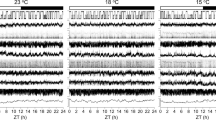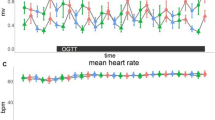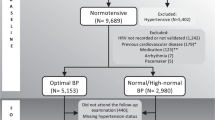Abstract
OBJECTIVE: Conflicting results have emerged over the nature of autonomic nervous system abnormalities in human obesity. This present study was designed to investigate the sympatho-vagal activities and their responsiveness to acute cold exposure in age- and height-matched obese and non-obese young women.
SUBJECTS: Twenty-four age- and height-matched obese (Weight: 68.1±2.64 kg, BMI: 26.3±0.74 kg/m2, %Fat: 39.9± 1.23%) and non-obese young women (Weight: 46.9±0.77 kg, BMI: 18.5±0.18 kg/m2, %Fat: 22.9±0.8%).
MEASUREMENTS: Plasma leptin, insulin, glucose and lipid concentrations were measured at rest. The sympathetic (SNS) and parasympathetic (PNS) nervous system activities were assessed by means of power spectral analysis of heart rate variability (HRV) for 15 min under control (25°C) or acute cold exposure (10°C) conditions. The very low (VLO) frequency component, and SNS (low/high power), and PNS (high/total power) indexes were used to evaluate thermoregulatory sympathetic function, and cardiac sympathetic and parasympathetic nervous activities, respectively.
RESULTS: Plasma leptin concentration was significantly greater in the obese than in the control group (47.3±7.00 vs 12.1±1.22 ng·ml−1, P<0.001). There was a highly positive correlation between plasma leptin concentration and percent of body fat (r=0.863, P<0.001). During the resting condition, there was no significant difference in any of the parameters of the HRV between the obese and control groups. Upon acute cold exposure, the VLO frequency component associated with thermoregulation (309±49.9 vs 578±142.2 ms2, P<0.05) as well as its responsiveness (25–10°C delta changes: 17±82.9 vs 326±138.2 ms2, P<0.05) were significantly lower in the obese than in the control group.
CONCLUSION: Our data indicate that a reduced autonomic, especially sympathetic responsiveness associated with thermoregulation and possibly leptin resistance might be aetiological factors of obesity in young women.
This is a preview of subscription content, access via your institution
Access options
Subscribe to this journal
Receive 12 print issues and online access
$259.00 per year
only $21.58 per issue
Buy this article
- Purchase on Springer Link
- Instant access to full article PDF
Prices may be subject to local taxes which are calculated during checkout
Similar content being viewed by others
Author information
Authors and Affiliations
Rights and permissions
About this article
Cite this article
Matsumoto, T., Miyawaki, T., Ue, H. et al. Autonomic responsiveness to acute cold exposure in obese and non-obese young women. Int J Obes 23, 793–800 (1999). https://doi.org/10.1038/sj.ijo.0800928
Received:
Revised:
Accepted:
Published:
Issue Date:
DOI: https://doi.org/10.1038/sj.ijo.0800928
Keywords
This article is cited by
-
Seasonal differences in brown adipose tissue density and pulse rate variability in a thermoneutral environment
Journal of Physiological Anthropology (2018)
-
Effects of ABCB1 gene polymorphisms on autonomic nervous system activity during atypical antipsychotic treatment in schizophrenia
BMC Psychiatry (2018)
-
Long term effects of smoking cessation in hospitalized schizophrenia patients
BMC Psychiatry (2017)
-
The influence of body mass index and outdoor temperature on the autonomic response to eating in healthy young Japanese women
SpringerPlus (2014)
-
Evaluation of autonomic nervous system by salivary alpha-amylase level and heart rate variability in patients with schizophrenia
European Archives of Psychiatry and Clinical Neuroscience (2014)



